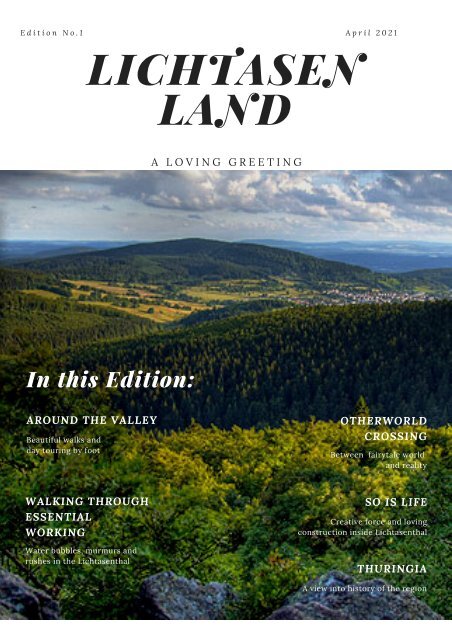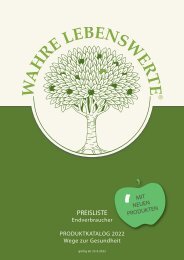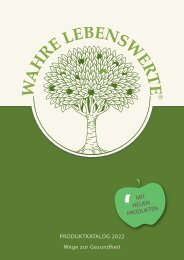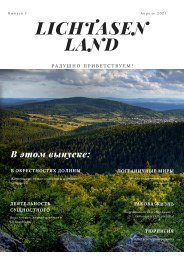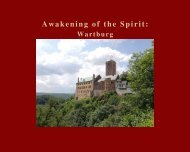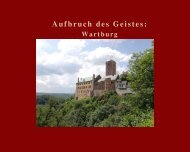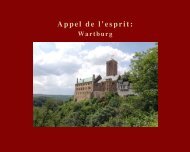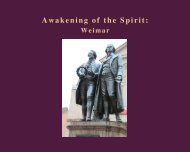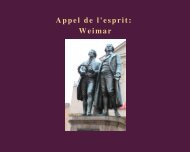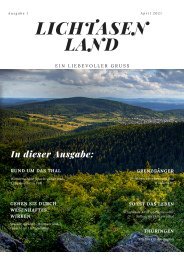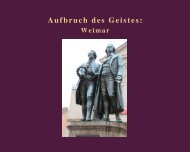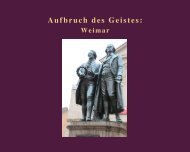Lichtasenland Edition 1/2021
- No tags were found...
You also want an ePaper? Increase the reach of your titles
YUMPU automatically turns print PDFs into web optimized ePapers that Google loves.
E d i t i o n N o . 1 A p r i l 2 0 2 1<br />
LICHTASEN<br />
LAND<br />
A L O V I N G G R E E T I N G<br />
In this <strong>Edition</strong>:<br />
AROUND THE VALLEY<br />
Beautiful walks and<br />
day touring by foot<br />
OTHERWORLD<br />
CROSSING<br />
Between fairytale world<br />
and reality<br />
WALKING THROUGH<br />
ESSENTIAL<br />
WORKING<br />
Water bubbles, murmurs and<br />
rushes in the Lichtasenthal<br />
SO IS LIFE<br />
Creative force and loving<br />
construction inside Lichtasenthal<br />
THURINGIA<br />
A view into history of the region
Lichtasen<br />
Land<br />
Country walks<br />
Along the ponds and the little stream<br />
From the Waldschlösschen simply walk along the Lichtasenthal. See<br />
the reflecting light on the water, listen to the stream and the birds.<br />
Breathe in the fresh forest air and perceive the energy of the<br />
surroundings. This is how a wonderful visit to the <strong>Lichtasenland</strong><br />
begins, full of energy and joy.<br />
Circular trail to the Questenstein with a view, approx.5 km, 2 hours<br />
From the Waldschlösschen follow the path westwards with the<br />
markings yellow bar on a white field, towards Kleefleck. At Kleefleck<br />
turn right into the "Breitunger Rennweg" with many border stones<br />
towards Questenstein (marked green/yellow/red). Be watchful, there<br />
are several rustic beeches, worth mentioning. After another 600m you<br />
will see the turn-off to Questenstein on the left (from the crossroads<br />
approx. 300m). Return to this junction and follow the signs to the car<br />
park at "Unterer Beerberg". At the car park, go slightly downhill to<br />
Lichtasenthal. In the valley, keep right along the stream towards<br />
Waldschlösschen.<br />
Walk with a view over Brotterode approximately 4km 1 hour<br />
From Waldschlösschen follow the valley up to the turning with the<br />
bridge to "Brotterode" (yellow bar on white). Continue up the valley<br />
following the markings. At the end of the valley (after approx. 700m)<br />
turn right and walk slightly uphill. After approx. 200m turn right<br />
(Nordic Walking route blue) and follow the path around the hill in an<br />
anti-clockwise direction. After almost 2km you will come to a<br />
wonderful viewpoint over the spa town of Brotterode. Continue on the<br />
path around the hill once completely and back to Lichtasenthal.<br />
country walks 06
The waterfall<br />
Water is mobile and wonderfully reflects the spirit thirsting for<br />
knowledge. It flows and soaks every gap, it penetrates the smallest nooks<br />
and crannies to emerge discerning after the experience. The desire for<br />
this project arose because of the beauty of the rocks.<br />
In 1865 the waterfall was created by Trusetal miners under the<br />
supervision of Baurat Specht. A dam diverts the water from the Truse<br />
below Brotterode. At first, the 3.5 km long, constructed waterfall ditch<br />
winds along the edge of the forest and then approaches the actual river<br />
valley again. At Öhmigshauk, the Trusetal waterfall first falls over two<br />
smaller falls and then over the granite rock from a height of 50m into a<br />
collecting basin. The water then flows back into the Truse.<br />
The Trusetal Waterfall is only in operation from Easter to the end of<br />
October each year. A circular walk, starting at the waterfall with 228<br />
steps, brings us closer to the water and lets us see rainbows.<br />
Accompanying festival events are the annual waterfall festival in July<br />
and a small summer market.<br />
Hike on page 13: From Waldschlösschen 4km to the waterfall. Walking<br />
around the waterfall and back the same way is about 9km.<br />
07
A refreshing-senses day tour<br />
14 KM HIKE WITH VIEWPOINTS, REFRESHMENT STOPS,<br />
CASTLE & PARK, BAROQUE GARDENS, KNIGHT'S CHAPEL,<br />
ROMANTIC PICNIC AREA, ROTUNDA<br />
Castle & Park Altenstein<br />
Altenstein Castle is an excursion<br />
destination with a park and court<br />
marshal's facilities (also an Inn). The<br />
landscape park is considered a baroque<br />
jewel with a variety of park architecture.<br />
These include The Chinese Tea House,<br />
the Flower Basket, Boniface Rock and<br />
Knight's Chapel. The castle ruins (directly<br />
behind the castle with its witch's tower)<br />
bear witness to its origins around 1120<br />
under the knightly dynasty "von Stein".<br />
The hiking trail (yellow bar on white)<br />
starts at Waldschlösschen following up<br />
the valley, then towards Unterer<br />
Beerberg parking, Kratzersrasen and on<br />
to Steinbach. In Steinbach (west side) the<br />
trail starts through the hilly park at the<br />
Pakplatz in Glasbachstrasse at the<br />
information board. There one follows the<br />
signpost to the "Rotunde". From there it<br />
is easy to continue to the "Morgentor"<br />
Rock (signpost) and later the Chinese<br />
house (picnic area inside and outside!)<br />
and further on to the Flower Basket Rock<br />
(a typical 1800 phenomenon). From there<br />
it is just a shor walk through the<br />
secluded beech forest to Altenstein<br />
Castle. The colourful baroque flowerbeds<br />
are worth seeing and the castle invites us<br />
with a beautiful view.<br />
view to the Rhön mountains<br />
knot flower beds at the castle<br />
Chinese house<br />
Hiking 08
Beautiful essential beings landscape<br />
gardens, embedded baroque<br />
architecture, panoramic views, fresh<br />
forest air, places of contemplation,<br />
fairy meadows, flower splendour and<br />
a redwood baby tree.<br />
You can walk through the entire park and<br />
admire the baroque flowerbeds, tree<br />
monuments and the knight's chapel.<br />
From here you can either take the bus<br />
back to Brotterode or hike back.<br />
The way back leads via the Altenstein<br />
cave (past Glücksbrunn Castle) to<br />
Steinbach, then via Schindgasse to the<br />
Hohle car park (information board). From<br />
there, follow the "green bar on white"<br />
markings in the direction of Atterode<br />
(also to the former Arminius mine).<br />
Follow the stream uphill towards<br />
Judenkopf, but in the direction of<br />
Kleefleck and back to Waldschlösschen.<br />
fairy gardens at the castle<br />
Wonderful impressions of nature and<br />
views of the surrounding area. The<br />
extensive Altenstein Landscape Park is<br />
a gem with peaceful squares,<br />
mythological figures and park<br />
architecture adapted to the natural<br />
forms. Exploring the park alone is<br />
worth the trip, even by car.<br />
www.schloss-altenstein.org<br />
Altenstein Castle<br />
A special feature of Altenstein Castle<br />
is its extensive and magnificent park.<br />
A castle existed from as early as 700<br />
and had a chequered history until<br />
1630, when the dukes of Saxe-<br />
Meiningen took over the castle.<br />
When the building was destroyed by<br />
fire in 1733, Duke Anton Ulrich of<br />
Saxe-Meiningen and his son<br />
converted the castle into a hunting<br />
lodge and then a summer residence.<br />
The cavalier buildings and gardens<br />
were built from about 1800 onwards,<br />
and the parks were extended and<br />
slowly shaped to their present<br />
beauty. You will find small quiet<br />
places with secluded spots, beautiful<br />
views, artistic flower arrangements<br />
and proud botany with trees from<br />
distant countries.<br />
09
A half day´s hike<br />
9km hike with Trusetal waterfall mining trail,<br />
visit to the sound trail with wildly romantic<br />
path in Truse valley.l<br />
Beginn des Wasserfallgrabens, ca. 1,8km oberhalb des Parkplatzes<br />
The Waterfall & the Truse<br />
The Truse has been mentioned in<br />
documents since 930 AD and was once an<br />
important mill river. Today it murmurs<br />
through the valley, telling stories...<br />
We start at the Waldschlösschen in the<br />
direction of Kleefleck (1km) and turn left<br />
there in the direction of Laudenbach<br />
(marked with a green bar). After approx.<br />
1km keep left (direction Brotterode) and<br />
then turn right after approx. 200m,<br />
through the weavers' meadows to<br />
Laudenbach. In Laudenbach you will<br />
come across the mining trail (2 crossed<br />
hammers), which leads us to the Trusetal<br />
waterfall (approx. 1km). We stay at the<br />
ditch of the waterfall and reach the<br />
falling water from atop, following the<br />
stairs down, you can walk around the<br />
spectacle and go straight back or<br />
additionally visit the "sound path". The<br />
sound path begins 300m behind the ice<br />
cream café, past the "Zwergen-land" car<br />
park (cross the Trusenbrücke bridge) on<br />
Laudenbacher Strasse (signposted path<br />
to own car park). The circular route is<br />
approx. 700m long. In hot weather the<br />
path back through the Truse valley is<br />
cool and shady, but the last 2km are on<br />
the road. You can return to Laudenbach<br />
by following the waterfall ditch in front<br />
of the ice cream café and then return<br />
along the familiar mining trail.<br />
Truse and a possible derivation of the name<br />
Open from April - November<br />
Entrance free<br />
from 9 o´clock until dawn<br />
(guided tours possible)<br />
© www.klangpfad-trusepark.de<br />
In Norse mythology, Thrud is - goddess of vegetation,<br />
power and strength. She is the goddess of trees, flowers,<br />
grass and willows, as well as the protective goddess of all<br />
nature beings. She is said to live high in the trees, in her<br />
Thruden's nest, the mistletoe, which is also considered a<br />
magic herb. As one of the Valkyries, Thrud is also<br />
responsible for storms and clouds. Therefore, the rune<br />
Thurisaz, assigned to this goddess, stands for (female)<br />
power and strength, for protection and defence, as well<br />
as for storms. The parents of the Norse Thrud are the<br />
harvest goddess Siff and the thunder god Thor. The root<br />
of her name goes back to the Old Norse "Throta", the<br />
Middle High German "Trute" or the Gothic "Trudan". On<br />
the one hand, it means strength or power, on the other<br />
hand, it also means to press, stomp or push. -just ike a<br />
little river would do.<br />
www.artedea.net<br />
13
Poetry for the hike<br />
In the middle of the water<br />
The oak rose like a hermitage,<br />
Majestic princely seal<br />
To such green forest foliage;<br />
Watching itself at its feet,<br />
Seeing the sky in the flood:<br />
So to enjoy slow life´s beat<br />
Solitude is highest good.<br />
Johann Wolfgang von Goethe<br />
(world literat, Naturalist)<br />
“Everybody needs beauty as well as bread,<br />
places to play in and pray in,<br />
where Nature may heal and cheer<br />
and give strength to body and soul alike.”<br />
John Muir (Preserver of Yosemite valley, never visited Thuringia)<br />
Strive for tranquillity, but through balance,<br />
not by the standstill of its activity.<br />
– Friedrich von Schiller<br />
Those who contemplate nature are captivated<br />
by the mystery of life.<br />
– Albert Schweitzer<br />
(Theologian, doctor, writer, pacifist)<br />
Poetry 14
Art & Nature<br />
Nature and Art still shun each other’s sight,<br />
Yet mate as fellows, ere one wotteth well.<br />
My stubborn mood hath long since left me quite;<br />
So, which most draweth me I scarce may tell.<br />
There needs must be a strait and true endeavor:<br />
But, the full doe once paid—of life we owe,<br />
Bound mind and will as thralls of Art forever,<br />
Fiercely at heart as erst may Nature glow!<br />
Like token market every high emprise.<br />
All spirits undisciplined strove in vain to stand<br />
Where heights of pure perfection reach the skies.<br />
Who great things would, shall hold his soul in<br />
hand.<br />
Only self-mastered may man master be,<br />
And law fulfilled, alone can speak us free!<br />
Who else but nature<br />
can we ask to know<br />
how we should live,<br />
to live well?<br />
Christoph Martin Wieland<br />
(poet of the enlightenment)<br />
Johann Wolfgang von Goethe<br />
translation by Robyn Lowrie (www.frenchquest.com)<br />
Solitude, seclusion from people,<br />
outer quietness around me and<br />
inner occupation are the only state<br />
in which I still thrive.<br />
Friedrich Schiller<br />
Come forth, young man, into the open field, and mark:<br />
the most ancient, most glorious revelation of God<br />
appears to me every morning as fact,<br />
the great work of God in nature.<br />
Johann Gottfried von Herder (cultural philosopher)<br />
15
Otherworld Crossing<br />
BETWEEN FAIRY TALE & REALITY<br />
THE FOLIAGE MAN<br />
In the old town of Ruhla, for centuries, in early summer, as soon as the forest was green again,<br />
young people and children would go out into the forest and tie one of their boys completely in<br />
green branches so that only his shoes were visible. A slit was left for the eyes, but the branches<br />
protruded above the head and were tied together to form a point. Then the "little leaf man", still<br />
draped with colourful ribbons and scarves, was led into the town amidst singing and joy. A kind of<br />
spring festival with dancing and special old folk songs then took place under the lime tree or at the<br />
market.<br />
The "foliage man" is the personified spring itself or the old Germanic god of light "Baldur", who, dead<br />
in winter, was now awakened to new life. This custom was common in the Thuringian Forest until<br />
around 1840.<br />
THE WUWWERBÖZER<br />
Since ancient times, a powerful mountain spirit has lived in the mountains and forests of Ruhla.<br />
Even at the time when no humans inhabited the Ruhla valley, he was the lord of the mountains. He<br />
had power all the way to the tops of the trees and down into the depths where precious ores and<br />
wonderful treasures lay. In his subterranean kingdom, which has a centre in the Ringberg, it shines<br />
with precious metals and stones. Dwarves and gnomes, later called hats by the inhabitants of Ruhla,<br />
were in his service. They collected the treasures, extracted and worked ores, and were active here<br />
and there in the woods and fields. Later they were also sent out to help the hard-working people in<br />
the Ruhl, the miners, smelters and blacksmiths.<br />
The Ringberg is also the actual residence of the mountain and forest spirits. It is said to be large<br />
rooms similar to a palace. From a pulpit on the unwooded height of the mountain, the area in which<br />
the mountain spirit can exercise his power can be easily overlooked. In his realm above the earth,<br />
he was the guardian of the landscape. He cared for the animals, the trees of the forest, the plants<br />
and flowers in the fields and groves. He also played with them, as well as with the waters and the<br />
rocks of the mountains.<br />
When the people came to the land, he was not hostile to them, but always felt like observing and<br />
getting to know them in their activities. He watched the miner, the charcoal burner and the forest<br />
smith at their work. He accompanied the hunter on his hunt for game, helped the woodcutter with<br />
his hard work, and the cattle farmer with cutting grass and making hay on the barren mountain<br />
meadows. He drove the herd to the forest pasture with the shepherd, hiked or drove over stony<br />
paths with the merchant, pushed the cart or helped to brake.<br />
He could take on many different guises and was often invisibly present. Sometimes he did people<br />
good, but he also teased and frightened them. Evil-doers, cheats and hard-hearted people were<br />
treated bitterly.<br />
People soon noticed the existence of the mountain spirit. When they thought they would meet him<br />
or thought he was nearby, their hearts beat faster with excitement or fear, bubbled more violently -<br />
they said it was worth it.<br />
But the spirit also made it a point to make the wicked fearful by will-o'-the-wisps or sudden rushes<br />
and gusts of wind, even thunderous blows - to bogey them.<br />
That is why they gave him the name Wuwwerbözer - which was meant to express timidity and awe of<br />
him. He can be recognised by his oversized figure. He is dressed in a wide-brimmed hat, a dark<br />
reddish shimmering cape and a gnarled branch as a mountain stick. If he appears in another form, he<br />
is not recognisable to people.<br />
(Source: legends of Ruhla and area)<br />
Otherworld crossing<br />
18
Legends & fairytales<br />
BETWEEN FAIRYTALE FOREST &<br />
REALITY<br />
MRS. PERCHTA AND THE BROWNIES<br />
In the fertile Saale valley between Ruhla and Wilhelmsdorf, Perchta, the<br />
queen of the brownies, had taken up residence, and her invisible<br />
proximity spread happiness, prosperity and cheerfulness over the whole<br />
area. The inhabitants of the valley were such good friends with the<br />
brownies, that they took pleasure in the little ones' games and teasing,<br />
in their sudden appearances and disappearances during their work in<br />
the fields. It was a joyful activity and everyone was diligent in their daily<br />
work.<br />
Thus, the people lived a happy, joyful life for a long time. Mrs. Perchta was known for her kindness<br />
and severity. She had two faces, so to speak. Sometimes mild like the young spring and sometimes<br />
severe like the cold winter, depending on how the people rejoiced or just wanted to complain.<br />
But then discord arose between the people and Perchta. The reason was as follows: a long time ago,<br />
a greying man came from a foreign land and warned the people that Perchta was not to be trusted.<br />
He said, the little ones she ruled over were little human children who had died before being<br />
baptised and had thus fallen prey to Perchta. Once a year, on the night before the Feast of the<br />
Epiphany, she was given the power to work her wiles on people. Such talk made people suspicious,<br />
for they knew the seemingly dark face of the Perchta as well as the friendly one. Over a long period<br />
of time they began to fear Mrs. Perchta and her brownies more and more, and everything bad that<br />
happened in the valley was attributed to her; they avoided her fearfully and locked the children up<br />
in their homes. The joy of the people became less, they looked around more and more suspiciously.<br />
Bad harvests came and the people now put all the blame on Frau Perchta.<br />
One "Perchta" evening (the night before Epiphany), the ferryman from the village was ordered to<br />
cross the river late at night, at about the twelfth hour. When he came to the bank of the river Saale,<br />
he saw a stately woman surrounded by a large crowd of weepers who looked like children. Startled,<br />
the man remembered that it was "Perchten- night" and wanted to hurry back to his flat. But the<br />
woman threateningly demanded to cross the river. She stepped into the vehicle, the brownies<br />
followed and dragged a plough and a lot of other equipment into the barge. As they did so, they<br />
complained loudly that they had to leave the beautiful area.<br />
The skipper pushed off, and when Perchta had reached the other shore, she ordered him to sail<br />
again and to fetch all the littl ones who had stayed behind. This too was done. In the meantime<br />
Perchta had been whittling at the plough, pointed to the large heap of wood chips and said to the<br />
ferryman: "Here take this, this is the reward for your toil!" Grumpily, the man<br />
pocketed some of the shavings, threw them on the window sill at home and<br />
went to bed. The next morning there were three golden pennies in the<br />
place where he had put the wood chips. He ran off at once, but on the<br />
whole river-bank the ferryman could not find any more no matter<br />
how diligently he searched. It is said that Mrs. Perchta had moved<br />
to the direction of the Werrathal and had found a new home<br />
for herself and her little helpers, where people appreciated her<br />
doings.<br />
Source: Legends of Thuringia<br />
19
C R E A T I V E F O R C E<br />
Projects<br />
at Lichtasenthal<br />
The animals inside<br />
the valley<br />
FALLOW DEER<br />
The white stag pleases the eye anew every day.<br />
The group of deer looks over to visitors and are<br />
also interested in people. Sometimes they are a<br />
little shy, but this passes after a few minutes.<br />
They are the typical representatives of the game<br />
in the Thuringian Forest. They enliven the<br />
meadows with their noble gait and upright<br />
heads. When the stags shed their antlers, they<br />
can be used for buttons, decorative carvings and<br />
many other things. The stag itself gets new<br />
antlers, which become larger than the previous<br />
ones. The white stag is also a mystical deer.<br />
THE SHEEP<br />
They work diligently at "mowing" (= "mähen" -<br />
like the sound of a sheep in German) and<br />
keeping the meadows in the nature reserve in<br />
order. In spring around Easter there were lambs<br />
to greet. The woolly helpers can be noisy at any<br />
age. They enrich the soil organisms. With them<br />
come the dung beetle and help to create good<br />
soil.<br />
INDIAN RUNNER DUCKS<br />
The "Indian runners" in a colourful troop are now<br />
waiting to be used as assistant gardeners. They<br />
are good snail eaters and help to make the salad<br />
and vegetable harvest bigger. They love a pond<br />
to splash around in and are otherwise very<br />
independent in their search for food.<br />
"But everything he had seen strengthened his conviction: That man - on the<br />
one hand related to the beasts of the field, on the other to the higher beings<br />
and the Godhead itself - was just as incapable of being a mere animal as a<br />
mere spirit; but that he only lived according to his nature when he always<br />
rose upwards. "<br />
Christoph Martin Wieland<br />
(from "Stories of Agathon")<br />
Projects 20
C R E A T I V E F O R C E<br />
The dry stone wall<br />
The pair of swans<br />
The new dry stone wall at the Waldschlösschen<br />
will offer a variety of habitats.<br />
Those stone monuments have been built for<br />
thousands of years and are a typical landscape<br />
element everywhere. They exist as retaining<br />
walls or as free-standing walls, at houses and in<br />
gardens in a variety of designs all over the world,<br />
made of the rock available in each case.<br />
The cracks in the wall provide habitats for<br />
beautiful plants and various small animals. It is<br />
nice when lizards and slow-worms come to visit<br />
and have food and a place in the sun. The rock<br />
stores heat and releases it to the surrounding<br />
area, which also benefits what is planted in front<br />
of it.<br />
In permaculture, open masonry provides a<br />
home for a variety of animals and insects and<br />
increases the health and diversity of a garden or<br />
landscape. The more diverse the natural<br />
inhabitants of a garden, the better the biological<br />
balance.<br />
Building a dry stone wall requires patience,<br />
strength and an eye for stones that fit together.<br />
Such an element connects the earth with the air,<br />
stores moisture and can be warming - similar to<br />
a fire.<br />
In July we have a pair of swans to welcome at the<br />
Waldschlösschen. The swan with its nature stands<br />
for grace, beauty and mercy. This is easy to<br />
understand when you watch how these wonderful<br />
birds behave. According to animal symbol expert<br />
Regula Meyer, it is not about outer beauty but inner<br />
beauty and grace. It is about awakening the light in<br />
us. The swan inspires our perception to rise to the<br />
highest levels, to open our light eyes and find<br />
spiritual experiences. "Plant a light in your inner<br />
heart and marvel at the growth and inner strength<br />
and beauty". This experience can make us bow our<br />
heads - just like a swan: experiencing, ennobling,<br />
graceful and humble, it makes our appearance<br />
outwardly, through inner experience, graceful and<br />
beautiful.<br />
It is said that a swan flew into the light up to the<br />
steps of God's throne. This experience made his<br />
feathers pure white and through this blissful<br />
sensation in his heart he always bowed his head in<br />
noble humility about this experience from then on.<br />
(inspired by the book "Tierisch gut" by Regula Meyer)<br />
"Create for yourself within yourself;<br />
this creating,<br />
by giving you to yourself,<br />
gives you to the world."<br />
Wilhelm von Humboldt<br />
21<br />
www.stiftung-rufe.de/<strong>Lichtasenland</strong>
LICHTASEN<br />
LAND<br />
"So there that blood also ran cold<br />
That once was accustomed to flow,<br />
So the nerves, too, quivered to rest,<br />
And night was all to the senses.<br />
And heart and brain must be still:<br />
You are dust and lifeless clay alone.<br />
Ah eternity-longing, thou wondrous!<br />
There is but dust, a deed and a name.<br />
For every good thought<br />
Dieth no more so long,<br />
Till from its germ<br />
A better one sprang up.<br />
Light across the land.<br />
Light across the land, -<br />
That's what we want."<br />
Jens Peter Jacobsen<br />
(danish poet)<br />
E d i t i o n N o . 1 A p r i l 2 0 2 1


